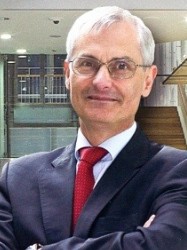Summary
Professor Roger Whatmore’s main research interests and expertise are in the field of Functional Materials, with particular emphasis on ferroelectrics, multiferroics and their applications. After receiving a 1st class honours from Cambridge University, he carried out his PhD research at the Cavendish Laboratory, subsequently joining Plessey Research at Caswell in 1976 (which became a part of GEC Marconi in 1990). There, he worked on the applications of ferroelectrics ceramics, thin films, single crystals, polymers and ceramic/polymer composites in electronic devices ranging from pyroelectric thermal imaging arrays, through piezoelectric sensors, transducers and SAW devices, to electro-optical modulators, non-volatile memories, capacitors and microwave resonators. In 1993 he led the team which won the Prince of Wales Award for Innovation for the development of a wearable thermal imager for firefighters and GEC recognised his contributions through the award of their Nelson Gold Medal in the same year. The technology underpinning this formed the basis of a very successful company – Infrared Integrated Systems Ltd - which now has sales of over £30M and employs more than 100 people.
In 1994, he moved to Cranfield University, as the Royal Academy of Engineering Professor of Engineering Nanotechnology, where he established a very successful team applying ferroelectric materials to the areas of microsystems and nanotechnology, and becoming Head of Advanced Materials.
In January 2006, he took up the post of CEO at the Tyndall National Institute, part of of University College Cork, Ireland, which is internationally respected for the high quality research in the areas of photonics, micro-nanoelectronics, electronic systems, functional materials and nanotechnology, underpinned by excellence in theoretical modelling and design. He secured almost €50M to develop the Tyndall site with a new laboratory building, set in place strategies that increased the annual research spend from €23M in 2005 to €33M in 2011, with researcher numbers growing from 300 to >450 in the same period and injected a further €60M of capital investment. Under his direction the influence, financial status and academic status of Tyndall increased dramatically and a Science Foundation Ireland instigated international review body concluded that “Tyndall is an indispensable national resource”, “Based on the high quality of the projects … we conclude that the research … at Tyndall is first-rate”. His strategy of driving the Institute towards an emphasis on systems applications of its technology, in the end-uses of Communications, Energy, Healthcare and Sustainable Development has led to a €20M investment in sustainable energy systems research (the International Energy Research Centre) at Tyndall.
Professor Whatmore is a fellow of the Royal Academy of Engineering, the Institute of Physics, IOM3 and the Irish Academy of Engineering. He was awarded the GEC Nelson Gold Medal in 1993 and the IOM3 Griffith Medal and Prize in 2003. In 2012, he retired as Tyndall’s CEO and was made an Emeritus Professor of University College Cork and in 2013, he became a visiting professor in the Department of Materials, Imperial College London.
Selected Publications
Journal Articles
Varghese J, O'Regan C, Deepak N, et al., 2012, Surface Roughness Assisted Growth of Vertically Oriented Ferroelectric SbSI Nanorods, Chemistry of Materials, Vol:24, ISSN:0897-4756, Pages:3279-3284
Correia TM, Young JS, Whatmore RW, et al., 2010, Investigation of the electrocaloric effect in a PbMg<sub>1/3</sub>Nb<sub>2/3</sub>O<sub>3</sub>-PbTiO<sub>3</sub> relaxor thin film (vol 95, 182904, 2009), Applied Physics Letters, Vol:97, ISSN:0003-6951

